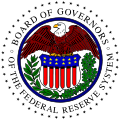- Chairman of the Federal Reserve
-
Chairman of the Board of Governors of the
Federal Reserve System
Seal of the Federal ReserveAppointer President of the United States Inaugural holder Charles Sumner Hamlin Formation August 10, 1914 Website Bios The Chairman of the Board of Governors of the Federal Reserve System is the head of the central banking system of the United States. Known colloquially as "Chairman of the Fed," or in market circles "Fed Chairman" or "Fed Chief". The Chairman is the "active executive officer" (see 12 U.S.C. § 242) of the Board of Governors of the Federal Reserve System.
Contents
Overview
As stipulated by the Banking Act of 1935, the President appoints the seven members of the Board of Governors of the Federal Reserve System; they must then be confirmed by the Senate and serve for 14 years. Once appointed, Governors may not be removed from office for their policy views. The chairman and vice-chairman are chosen by the President from among the sitting Governors for four-year terms; these appointments are also subject to Senate confirmation.[1] By law, the chairman reports twice a year to Congress on the Federal Reserve's monetary policy objectives. He or she also testifies before Congress on numerous other issues and meets periodically with the Secretary of the Treasury.
Currently, the chairman is Ben Bernanke, a South Carolina macroeconomist nominated by George W. Bush and sworn into office on February 1, 2006, for a term lasting until January 31, 2010. He was nominated for a second time by President Obama in 2009. In 2010 he was confirmed by the senate for a second term, ending January 31, 2014. Bernanke succeeded Alan Greenspan, who served for more than 18 years during the terms of four U.S. Presidents.
The law applicable to the Chairman and all other members of the Board provides (in part):
-
- No member of the Board of Governors of the Federal Reserve System shall be an officer or director of any bank, banking institution, trust company, or Federal Reserve bank or hold stock in any bank, banking institution, or trust company; and before entering upon his duties as a member of the Board of Governors of the Federal Reserve System he shall certify under oath that he has complied with this requirement, and such certification shall be filed with the secretary of the Board.
Chairman of the Federal Reserve
See also: List of Chairmen of the Federal Reserve- Charles S. Hamlin (August 10, 1914 - August 10, 1916)--Chairman of the Board of Directors of the Federal Reserve System
- William P. G. Harding (August 10, 1916 - August 9, 1922)
- Daniel R. Crissinger (May 1, 1923 - September 15, 1927)
- Roy A. Young (October 4, 1927 - August 31, 1930)
- Eugene I. Meyer (September 16, 1930 - May 10, 1933)
- Eugene R. Black (May 19, 1933 - August 15, 1934)
- Marriner S. Eccles¹ (November 15, 1934 - February 3, 1948)--first Chair of the Board of Governors of the Federal Reserve System[2]
- Thomas B. McCabe (April 15, 1948 - April 2, 1951)
- William McChesney Martin, Jr. (April 2, 1951 - February 1, 1970)
- Arthur F. Burns (February 1, 1970 - January 31, 1978)
- G. William Miller (March 8, 1978 - August 6, 1979)
- Paul A. Volcker (August 6, 1979 - August 11, 1987)
- Alan Greenspan² (August 11, 1987 - January 31, 2006)
- Ben S. Bernanke (February 1, 2006 - )
¹ Served as Chair pro tempore from February 3, 1948, to April 15, 1948.
² Served as Chair pro tempore from March 3, 1996, to June 20, 1996.Historical note
The Board of Governors of the Federal Reserve did not exist prior to the major reorganization of the Fed in 1935 (Banking Act of 1935). Prior to that time, the "Federal Reserve Board" (created in 1913 under the Federal Reserve Act) had a Board of Directors. The directors' salaries were significantly lower and their terms of office were much shorter prior to 1935. In effect, the Federal Reserve Board members in Washington, D.C. were significantly less powerful than the presidents of the regional Federal Reserve Banks prior to 1935.[2]
Prior to 1935, the heads of the twelve district "Federal Reserve Banks" were called "Governors". In the 1935 act, the district heads had their titles changed to "President" (e.g., "President of the Federal Reserve Bank of St. Louis"), as part of a major shift of power to Washington.
Thus, Marriner Eccles was the first actual "Chairman of the Board of Governors of the Federal Reserve Board". The others prior to 1935 were "Chairman of the Board of Directors of the Federal Reserve System", with much more circumscribed power.
See also
References
- ^ {{cite news|author=Federal Reserve|url=http://www.federalreserve.gov/generalinfo/faq/faqbog.htm%7Ctitle=Board of Governors FAQ|work=Federal Reserve|date=January 16, 2009|accessdate=2009-01-16
- ^ a b Meltzer, Allan H. (2003). A history of the Federal Reserve: Volume 1, 1913-1951. Chicago: University of Chicago Press.
- Beckhart, Benjamin Haggott. 1972. Federal Reserve System. [New York]: American Institute of Banking.
- Shull, Bernard. 2005. The fourth branch: the Federal Reserve's unlikely rise to power and influence. Westport, Conn.: Praeger.
- Andrews, Edmund L. (Nov. 5, 2005). "All for a more open Fed". New Straits Times, p. 21.
Office of the Federal Register http://www.presidency.ucsb.edu/ws/index.php?pid=59049
External links
Federal Reserve System Federal Open Market Committee · Chairman of the Federal Reserve · Federal Reserve Bank Banknotes Reports Federal funds History Categories:- Chairmen of the Federal Reserve
- American bankers
-
Wikimedia Foundation. 2010.

